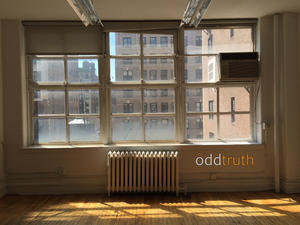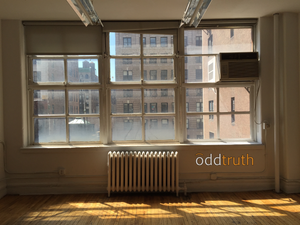Greetings everyone,
As most of you know by now, last year was really the first year we went all out in our strategy to maximize our presence at comic-cons throughout the US. We actually tried to use the data that we’ve gathered over the past years to see how we could be really effective whenever we traveled to a comic-con.
With that said, we’ve attached the normalized graphs of how well (or not so well) we did in 2013 and 2014. Bear in mind, actual amounts won’t be shown, and the images themselves are somewhat small as they’re screenshots from the summary information that Square provides. Also, aside from NYCC, for which we used had a booth in the same location, we were at the convention’s artist alley for all of the other convention. Which means that we had no say on our placement within the convention, a variable that affects how much traffic can pass by one’s table.
Oh, and before we forget, all times reported were in EST.
Baltimore Comic Con 2013
Saturday

Sunday

NYCC 2013
Thursday

Friday

Saturday

Sunday

Asbury Park 2014 (now East Coast Comic Con since 2015)
Saturday

Sunday

Long Beach Comic Expo 2014
Saturday

Sunday

Phoenix Comic Con 2014
Friday

Saturday

Sunday

NY Comic Fest 2014 (no longer exists, part of East Coast Comic-Con)
Saturday

HeroesCon
Friday

Saturday

Sunday
No graph. After the first 3 hours of not making a sale, I packed up and hung out with friends there. Sometimes, you have to know when to relax, enjoy the moment, and say “f*&^ it.”
Boston Comic Con 2014
Friday

Saturday

Sunday

Baltimore Comic Con 2014
Friday

Saturday

Sunday

NYCC 2014
Thursday

Friday

Saturday

Sunday

Barring NYCC (which we’ll discuss separately in a moment), what are some quick lessons that we can learn?
- The first few hours matter. And, truth be told, it makes sense. In the first few hours is when customers have the most amounts of cash on hand. It stands to reason that these are the hours they’re most likely to spend money. Therefore, it’s important that you can drive the most traffic to your table or booth during this time, as it increases the likelihood of someone buying your comic (or other wares that you sell).
- Conventions follow the laws of traffic, for the most part. And traffic can be modeled using something called a Poisson Distribution. To over it briefly, a Poisson distribution expresses the likelihood that a given number of events (in this case, a sale) will occur in a fixed time and/or space given that these events have a known average rate (which could be your sales process) and are independent of the time since the last event (ie, the last sale). For the most part, our graphs correspond to a Poisson distribution, though I’ve yet to calculate the actual parameters of it. I did qualify that statement because at a convention traffic is not steady or continuous. Rather, it sometimes can drop off completely due to a high-profile event like, say, a panel with a famous celebrity. If the convention is small enough (and small here I would define as less than 60K attendees), it can affect traffic significantly, skewing all probabilistic distributions.
- Be mindful of events and where you are on the floor. Knowing how far away you are from the closest restroom, the entrance/exit, and when certain “must-see” events occur will affect the traffic around your table, which in turn will affect how likely you’ll be able to sell your things. And while, yes, you will get some traffic from those who will were not able to go to the event, if the convention’s small enough the traffic is small enough that that lunch break will serve you better than feeling depressed on your booth because no one is coming by to buy your labor of joy and you simply don’t understand why.
- Have something that can divert traffic to you. It’s an unfortunate reality, but we as humans are not always the most accepting of species when it comes to trying new things or embracing change. This also applies to media in general and comics in particular. Which means that, as the creator of said new media, you must entice and capture your audience’s attention enough for them to come by and see what you’ve created. Now, this can be as simple as saying to a passerby: “Hello, would you like to see what I’ve made?” If you’re an artist, you can also have your own interpretation of a famous character, game, scene, etc. on display, that’ll capture a lot of attention, part of which will be receptive to other things you’ve made. As a writer, it’s trickier. What I’ve seen successfully done by Erica Schultz is to have a number of works made that cater to different audiences. For example, say you like a time traveling doctor with a surprisingly persistent accent from the British Isles, you might be the sort of person who enjoys a time travelling Winston Churchill as you talk to them about your main body of work.
- At the end of the day, this is a business. Yes, it’s amazing art and fantastic stories, and it’s the product of your blood, sweat and tears. But if you’re not actively out there, promoting what you’ve done, politely reaching out to people and encouraging them to give you a shot, no one will. Stop sulking on your table, stop waiting for people to come to you, go to them.
But, what about NYCC? Well, that’s entirely different for us. First off, we have a booth, which already changes the interaction between customer and seller, as those on the main floor may not be as interested on artwork or comics as those in Artist Alley. Second, in 2013, we were sharing the booth with Red Stylo, and as such we had a greater catalogue of merchandise to sell, while in 2014 we had the Oculus Rift, which completely demanded the customer’s attention on its own (here’s a recap of that) . With that said, don’t trust the graphs of NYCC unless you’re thinking of exhibiting on the main floor.
That’s it for now. We’ll (hopefully) do a breakdown on how we fared in 2015 and see how well (or how poorly) we’ve applied the lessons learned here.
Until next time.
Best,
-Nick D.


